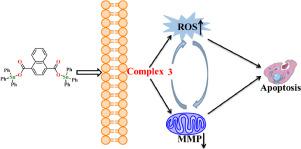Journal of Organometallic Chemistry ( IF 2.1 ) Pub Date : 2020-12-13 , DOI: 10.1016/j.jorganchem.2020.121654 Xiumei Du , Rufen Zhang , Qianli Li , Shuang Cheng , Yongxin Li , Jing Ru , Chunlin Ma

|
Seven organotin(IV) complexes, [(R3Sn)2L]n (R = Me 1, R = n-Bu 2), [(Ph3Sn)2L] (3), [(R2Sn)2L(μ3-O)]n (R = Me 4, R = n-Bu 5), [R2SnL(1,10-phen)]n (R = Me 6), [(R2SnCl)2L(1,10-phen)2] (R = n-Bu 7) derived from 1,4-naphthalenedicarboxylic acid (H2L) have been synthesized and characterized by elemental analysis, FT-IR, PXRD, NMR and X-ray crystallography. The single crystal diffraction reveals that complexes 1 and 2 represent 2D network structures, which both contain tetranuclear 26-membered macrocycles. Complexes 3 and 7 display dinuclear tin monomers, which can form 1D infinite chain by C-H•••O and C-H•••π interactions. Meanwhile, complexes 4 and 5 display 2D network containing tetraorganodistannoxane unit, while complex 6 adopts a 1D infinite chain structure, which further constructs 2D supramolecular architecture through C-H•••O intermolecular interactions. What's more, in vitro cytostatic activity of the complexes 1-3 against cervical carcinoma cell lines (HeLa), hepatocellular carcinoma cell lines (HepG-2) and human normal breast cell lines (HBL-100) have been investigated, and the results show that organotin derivatives with n-butyl and phenyl group (2 and 3) exhibit significantly higher anticancer activity than complex 1 with methyl group. Meanwhile, organotin(IV) complexes (1-3) display lower cytotoxicity than corresponding organotin(IV) precursors [trimethyltin chloride, bis(tri-n-butyltin) oxide and triphenyltin chloride] in HBL-100 cells. Furthermore, cytostatic assessments of complex 3 against HepG-2 cells reveal that the effect of cytostatic and apoptotic may through ROS-mediated pathway.
中文翻译:

1,4-萘二甲酸衍生的有机锡(IV)配合物:合成,结构,体外细胞抑制活性
七个有机锡(IV)配合物,[(R 3 Sn)2 L] n(R = Me 1,R = n -Bu 2),[(Ph 3 Sn)2 L](3),[(R 2 Sn)2 L(μ 3 -O)] ñ(R =我4,R = ñ -Bu 5),[R 2 SNL(1,10 -苯基)] ñ(R =我6),[(R 2的SnCl)2 L(1,10-phen)2 ](R = n -Bu 7合成了由1,4-萘二甲酸(H 2 L )衍生的),并通过元素分析,FT-IR,PXRD,NMR和X射线晶体学表征。单晶衍射揭示复合物1和2代表2D网络结构,都包含四核26元大环。配合物3和7显示双核锡单体,它们可以通过CH ••• O和CH ••• π相互作用形成一维无限链。同时,配合物4和5显示包含四有机二锡氧烷单元的2D网络,而配合物6采用一维无限链结构,可通过CH ••• O分子间相互作用进一步构建2D超分子体系。更重要的是,在体外的复合物的细胞生长抑制活性1 - 3对宫颈癌细胞系(HeLa细胞),肝癌细胞株(人肝癌HepG-2)和人正常乳腺细胞系(HBL-100)进行了调查,结果表明具有正丁基和苯基基团(2和3)的有机锡衍生物显示出比具有甲基的配合物1高得多的抗癌活性。同时,有机锡(IV)配合物(1 - 3)显示比相应的有机锡(IV)的前体[三甲基氯化锡,双(三-低毒性Ñ在HBL-100细胞-butyltin)氧化物和三苯基氯化锡。此外,针对HepG-2细胞的复合物3的细胞生长抑制作用评估表明,细胞生长抑制作用和细胞凋亡作用可能是通过ROS介导的途径引起的。











































 京公网安备 11010802027423号
京公网安备 11010802027423号